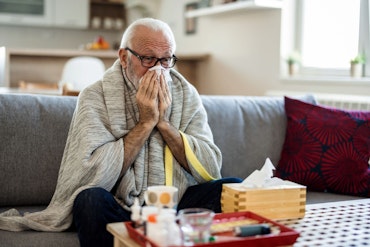Australia is too dependent on poorly funded aged care
Researchers from Flinders University in Adelaide, South Australia, have stated in a new Medical Journal of Australia article that Australia is a huge user of residential aged care even though there is a low financial investment into the entire aged care sector.
![<p>Australia has a majority of older people receiving care inside nursing homes even though the sector is inadequately funded. [Source: iStock]</p>](https://agedcareguide-assets.imgix.net/news/articles/news/articles/Australia-is-too-dependent-on-poorly-funded-aged-care-30_6_2020.jpg?fm=pjpg&format=auto&w=550&q=65)
Australia has a majority of older people receiving care inside nursing homes even though the sector is inadequately funded. [Source: iStock]
The research paper, Is Australia over-reliant on residential aged care to support our older population?, was authored by Suzanne Dyer, Madeline Valeri, Nimita Arora, Dominic, Tilden, and Maria Crotty, and funded by the Royal Commission into Aged Care Quality and Safety and the National Health and Medical Research Council (NHMRC) Cognitive Decline Partnership Centre.
In the Royal Commission’s Interim Report released late last year, it described the aged care system in Australia as “woefully inadequate” for older Australians and that aged care services “have simply not been seen as a priority by successive Australian Governments”.
One of the research experts, Flinders University Senior Research Fellow, Dr Suzanna Dyer, summarised the review of international approaches to aged care provision for the Royal Commission.
Dr Dyer says, “Australia provides institutional long term care for almost 20 percent of the population aged 80 years and older, and 6 percent of those aged 65 years and older.
“This places Australia as the nation with the highest proportion of older people living in institutional care compared with 11 other nations.
“The relative use of institutional care, as opposed to home or community care, was also highest for Australia, with 52.5 percent of long term care recipients aged 65 years and older, and 58.6 percent of long term care recipients aged 80 years and older in institutional care.”
Long term care in Australia is considered services for medical needs, personal care and assistance in living independently for people with long term dependencies due to their health care needs.
These services can be provided in institutions like residential aged care facilities, or by providing services to assist people to remain living in their own homes for longer through community services and respite care.
The aged care experts utilised Organisation for Economic Co-operation and Development (OECD) data from across 12 countries, based on the availability of information and similarities to the Australian aged care system, which showed that Australia relied too heavily on a sector that is not receiving proper investment from the Federal Government.
Authors on the study estimated the gross domestic product (GDP) expenditure by other nations on long term care for older people was much greater than Australia.
Further data shows that Australia also has a high proportion of older people living in institutions, like residential aged care facilities, even though there is a low financial spend on the sector.
Researchers also added that the wait list for Home Care Packages in Australia is likely impacting on the amount of people in residential care.
“While many countries have wait lists for home care services, the wait times of over 12 months for Home Care Packages at the approved level (for level 2 and above; i.e., beyond basic care needs, providing low to high level care) may lead to premature admission to institutional care for some people,” says the research paper authors.
“In November 2019, the Australian Government announced funding of an additional 10,000 Home Care Packages at a cost of $496 million. However, in September 2019, there were about 63,000 people waiting for an approved Home Care Package, and an additional 49,000 people were offered, while waiting, a package at a level lower than that approved.
“To reduce the number and proportion of older Australians living in residential aged care, there needs to be an increase in investment across the sector, particularly in home and community based care.”
To read the study, head to the Medical Journal of Australia website.











![The new Aged Care Act exposure draft is slated for release in December of 2023, but advocates hope to see it rolled out on January 1, 2024. [Source: Shutterstock]](https://agedcareguide-assets.imgix.net/news/articles/wp/agedcareact__0811.jpg?fm=pjpg&w=520&format=auto&q=65)












Comments